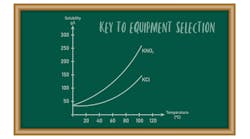Readers of this column know that I emphasize physical properties as the first step in understanding the behavior of a material or a piece of equipment. Color, hardness and shape are some simple examples of elusive properties that have clear definitions and ways to measure. However, a number of other properties can be confusing or very difficult to pin down. For instance, while we would like particle size to be a specific number that we can rely on, chemical manufacturers rarely deal with materials containing just a single size. So, we must characterize a material by its particle size distribution (PSD) to ensure we are making or buying the correct stuff. Unfortunately, such a characterization is not that simple. The size may represent an average of the mass, volume, surface area or some other physical property.
In one common PSD description, we use an average along with a range of sizes (i.e., 50% below the mass average of 50 micron, 10% below 10 micron and 10% above 100 micron). That sounds specific enough — but it really isn’t.
So, we use graphs to show how the particles are distributed. Most people look at these graphs and convert them back to the simpler description as described above. However, the shape of the curve tells a lot about your material — but seldom gets sufficient attention. For instance, a PSD that follows a Fibonacci series is less likely to attrite than one that is log-normal because the finer particles cushion the larger particles from wear and impact.
Another misuse of graphs is in conversion of the mass PSD to surface area. This requires a shape factor; it usually fluctuates with size. I reviewed a research program that was having problems producing the same product even when the starting chemical hadn’t changed. The team had PSDs that appeared to be consistent. However, they hadn’t examined the chemicals with a microscope. The crystals varied from batch to batch in shape but gave the same PSD as the composition changed. The problem was a polymorph that appeared when the starting solution’s concentration was too weak. You always want pictures of your particles to avoid this embarrassing situation.
You can obtain a PSD in many ways but results seldom agree. So, it’s important that you and your customer are on the same page. Help ensure this by sending a graph along with details on your procedure and equipment. The most common method to get a PSD is screening. Many different procedures (shaking time, frequency and even the use of media to prevent screen blinding) can be used along with a variety of screen shapes and materials of construction. Unfortunately, this method is time consuming and seldom makes sense for highly reactive or hazardous materials for obvious reasons.
Looking at particles with a microscope not only gives the size distribution but also the shape. By using a scanning or transmission electron microscope, you additionally can find chemical composition.
Many laser-based devices will give a PSD and, sometimes, even shape information. These devices offer the advantage of producing the graph and can be used off-line as well as integrated into the process.
You must pair the PSD with the method of analysis and how the sample was obtained. In my May 2016 column “Prevent Problems with Fine Particles,” I cited a problem in using thief samples made worse due to the short travel distance of the tanker truck. Our customer would grab a sample upon receipt of the tanker and claim it was too fine. Its sample didn’t represent the whole of the tanker. In addition, the customer was using grounded metal screens to check the sample while our plant was employing nylon screens. We fixed the sampling problem with a drop-through blender and the chute remained clean. The blender collected any fines; these were pushed out at the beginning of the next fill, solving the problem from our end.
Particle size distribution is what you make of it and how you use it. Be sure to select the most appropriate method of obtaining PSD and communicate details to your customer.


